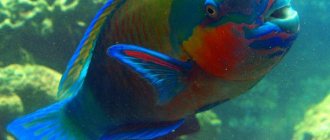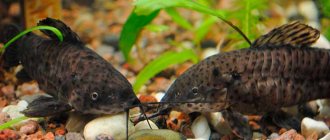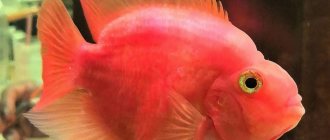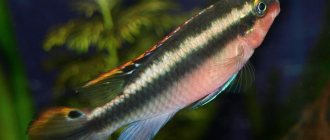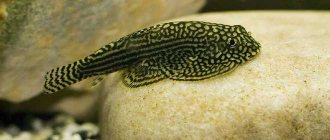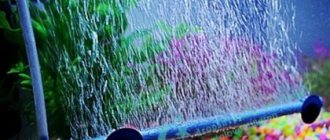Red parrot fish is one of the representatives of the large cichlid family, obtained through breeding work. As a result of crossing various cichlids, this unusual bird-fish of the aquarium world appeared, which almost immediately gained popularity among aquarists. Parrots are relatively unpretentious, incredibly beautiful and very energetic - these advantages do not allow interest in them to fade, and more and more aquarium lovers are getting such original pets. But, like all artificial breeds, parrotfish have some features that owners should familiarize themselves with before introducing these beauties into their home tank.
Habitat in nature
The red parrot fish cannot be found in the natural environment - it appeared as a result of the experimental activities of aquarists. The breed's homeland is Taiwan, where it was bred in 1964 using several species of cichlids, including cichlid severum and labiatum.
The fish are popular, so Asian breeders are in no hurry to reveal how they managed to get a new breed, and due to the inability of individuals to reproduce in captivity, their monopoly is maintained. They appeared on Russian territory in the 90s of the last century and quickly spread.
Feeding
What to feed red parrots? They eat any food: live, frozen, artificial, but due to the shape of their mouth, not all food is convenient for them to pick up. They prefer sinking pellets to floating pellets.
Most owners name bloodworms and brine shrimp as their favorite foods, but aquarists I know fed only artificial ones, and quite successfully. It is preferable to provide artificial food that enhances the color of the fish.
All large foods are suitable for them, from shrimp and mussels to chopped worms.
Description
Despite the fact that the fish almost immediately gained fans, debates about the advisability of breeding such hybrids do not subside, since representatives of the species have some disadvantages. For example, individuals have a tiny, mouth . This undoubtedly complicates the feeding process and does not allow parrots to resist other fish with a large mouth.
As a result of genetic transformation, the spine and swim bladder of the fish were deformed, which affects their swimming abilities. Such hybrids cannot survive in the natural environment, and they also need certain conditions in an aquarium. The red parrot has a round, body . This is a fairly large fish, growing up to 20-25 cm in length in good conditions.
Due to the modified shape of the spine and small fins, parrotfish swim somewhat awkwardly. Their tail is not very large either. There is another hybrid species of red parrot - the heart-shaped one, which does not have a caudal fin; these individuals look even less graceful.
Due to the fact that the fish nose and in a certain sense resembles a beak, they cannot be called cute. In some individuals, the canines and incisors show through. However, aquarists are more captivated not by the funny faces of the fish, but by their unusual, bright colors and funny habits, which cause a smile, and sometimes even tenderness.
Most often, the fish have a uniform color - red, yellow, orange. And since we are talking about an artificial breed, breeders do not stop experimenting, giving the fish bizarre shades using chemicals. Dyes are added to their food, and they become the owners of original colors. But the new owner is often disappointed - after some time, without the “color doping”, the specimens turn pale and the color of their scales changes.
Based on red parrots, new hybrid breeds with a huge variety of colors were bred. Albinos are even often found among representatives of the breed.
Variety of species
Red Parrots are classified by color. In its standard version, this type has a rich orange or red color. You can also find other natural colors - white, lemon-straw or orange-yellow. Subspecies include types of fish, classified by fin size and color scheme:
Marble (Marbled-Parrot) rich and deep marble range with an interweaving of light and dark spots
Panda (Panda-Parrot) is distinguished by resin specks on its body and abdomen of various shapes and sizes
King Kong (King-Kong-Parrot) is large in size, there is a massive fatty formation in the area of \u200b\u200bthe articulation of the head and body, the second growth is noticeable in the area of the ventral fins
Red Ingot (Kavalan-Red-Ingot) has a body flattened on the sides, slightly similar in shape to a scallarium, color – bright crimson
Pearl/Diamond (Killin-Parrot) very attractive delicate pearl color, the top of the body shimmers with neon when light hits it
Mammon (Kavalan-Red-Mammon)
distinguished by a large growth on the head, these are powerful individuals, whose height can reach up to 35 cm, a massive square body and a bright color from ruby to lemon
Many novice aquarists confuse Red Parrots with other fish - the Pelvicachromis-pulcher parrots. They are similar only in names, but they are a completely different type of fish.
How and what to feed parrotfish
When these fish with an unusual mouth appeared on the market, the owners encountered certain difficulties - not all food was suitable for feeding them. Today on sale you can find special ready-made diets intended for parrots.
Birdfish eat sloppily, leaving a lot of waste, so the tank will require frequent washing. The problem can be eliminated by adding non-aggressive medium-sized catfish to them - they will clean the bottom of food debris, preventing it from decomposing and rotting.
In general, red parrots are omnivores, and if the size of their food allows, they can eat both live and non-living food. It is recommended to choose a flake, granular or tablet product as a daily diet. You can diversify the menu with the following food:
- live or frozen bloodworms and brine shrimp;
- live guppies and goldfish;
- shrimp;
- worms;
- vegetable and meat products.
Representatives of the breed lose their bright color with age, so experts advise including foods rich in protein and beta-carotene in the parrots' diet to maintain their rich color. Parrots are fed at least 2 times a day, giving food in small portions.
Diseases
The immunity, like that of other cichlids, is strong. The disease goes away on its own. Treatment begins if symptoms of fish diseases appear:
- white stool;
- white lumps (like semolina) on the body and fins (ichthyophthyriasis);
- blackening of fins (color change is a sign of intoxication);
- lying on the bottom, spitting food (overeating, poisoning);
- wounds on the body.
The main reasons are poor water quality, overcrowding of the aquarium, and contact with other sick fish. If you rarely change the water, then intoxication occurs with your own feces. Then the water change should occur twice a day every day.
For ichthyophthyriasis, it is effective to increase the water temperature to 30 degrees Celsius, as well as the use of drugs containing copper.
Keeping in an aquarium
When breeding a hybrid breed, it was discovered that its representatives are prone to heterosis, that is, the fish are more viable than their ancestors. Parrots have good health, high immunity, and can tolerate changes in water parameters. All this allows us to recommend these fish to novice aquarists.
But there are still a number of requirements that should be adhered to when keeping pets of this breed:
- Parrots are large fish that leave a lot of waste and love to swim, so they need a large, spacious tank with a volume of at least 150 liters. In cramped conditions, their life expectancy is significantly reduced;
- water temperature varies between 26°-28°C;
- the maximum suitable stiffness is 5-7°, acceptable values are 2-25°;
- pH value 6.5-7.5;
- the presence of nitrogen compounds - ammonia, ammonium, is unacceptable;
- nitrate level no more than 30 mg/l;
- water must be filtered and provided with aeration;
- lighting should be moderate; parrots look most impressive in the red spectrum;
- There are no special requirements for the soil, the main thing is that there are no sharp pebbles that can injure the fish;
- It is advisable to place living vegetation in the tank - parrots, unlike other cichlids, are not “vandals”, but it is better to plant plants in the background and on the sides of the tank.
There is one caveat - although these fish do not produce offspring, they prepare for spawning and spawn in specially prepared nest holes. While preparing them, parrots can dig up plants, but usually they make depressions in the same places. To save the vegetation, it is enough to transplant it to another area. Parrots need shelters - labyrinths, grottoes, snags, etc.
Who do red parrots get along with?
Relatives of parrots are cichlids, which are not peaceful, but the bird fish themselves are quite calm and docile, so they can live in a common tank with other large inhabitants. The following fish can become “good” neighbors for them:
- angelfish;
- peaceful catfish - plecostomus, corydoras, Indian glass catfish, Kühl's acanthophthalmus;
- swordtails;
- tetras;
- dollar fish
If individuals of the above species nevertheless begin to show aggression towards the parrots, they may have to be placed in different tanks. At the very least, the owner should prepare for such a situation and at first carefully observe the pets and their behavior.
Compatibility
Who does he get along with? We must remember that although this is a timid cichlid, it is still a cichlid, and not a small one. So she perceives all small fish as food.
You need to keep it with fish of the same size, and if they are cichlids, then not aggressive ones - Cichlasma meeca, Cichlasoma Nicaraguan, Acara bluish-spotted, angelfish.
However, in my practice they got along with flowerhorns, but if you’re lucky, they may well kill the parrots.
Also suitable are tetras: Mettinis, Congo, Tetragonopterus and cyprinids: denison barb, Sumatran barb, bream barb.
Breeding Features
The artificial origin of the breed is associated with the crossing of many species of cichlids. This resulted in male red parakeets being sterile. But this did not affect the instincts of the fish, and if the water temperature in the tank rises above 25°, they begin to prepare for spawning: they tear up the soil and dig holes. In addition, representatives of the breed independently form strong pairs. However, the males are unable to fertilize the eggs and they remain nonviable.
Some aquarists manage to get mixed offspring if there is a fertile male of a species close to parrots in the aquarium, and he manages to fertilize the eggs. The fry will have similarities with the mother, and sometimes they will be almost copies, but with defects in color.
Experienced breeders claim that the fry are gray-black in color up to 5 months of age, and then become bright orange. They are fed in the same way as other aquarium offspring - Artemia nauplii or special liquid food intended for fry. In addition, the young animals are fed by the parents themselves, grinding pieces of food in their mouths and spitting them out in the center of the flock - this is a rather funny and touching sight.
The fry are fed 5-6 times a day. Also, do not neglect changing the water and siphoning the bottom - this will prevent the death of offspring from poisoning by rotting products. Parrots take care of the offspring, but conflicts and fights often arise in the pair. In such situations, it is better to remove the cichlids.
Red parrot fish are controversial aquarium inhabitants. They do not have grace, charming appearance or elegance, but their brightness, activity, and funny manners leave no one indifferent. In addition, they can live up to 10 years, which is quite a lot for such pets.
Reproduction
Breeding parrotfish at home in an aquarium is impossible. Males of this representative of cichlids are sterile and spawning is impossible. In the second year of life, pairs form, nests are dug, and eggs are laid. A couple of days later she dies. Fertilizes the eggs of the female of other cichlids. Then the offspring from breeding differ in appearance from parrots.
Sex differences
Distinctive features of males and females appear during the spawning period, when they reach the age of 1.5 years. In females, a pear-shaped tubercle is formed in the tail area, and in males, a cone-shaped tubercle is formed.
